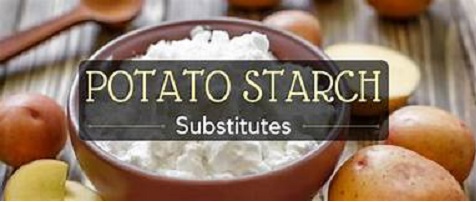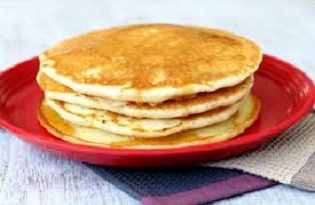Best Potato Starch Substitutes for Baking & Cooking Recipes
We have a comprehensive list of the top potato starch substitutes that may help you when short of potato starch while baking or cooking.

Do you find yourself in a situation where you need potato starch and have not got any?
Potato starch is a superb helper in the kitchen when you bake or cook since it is a thickening agent.
It’s often used to thicken, stews, soups, sauces, puddings, pancakes, custards.
Potato Starch Substitutes: Potato Starch Importance
Potato starch is vital if you are on a gluten-free diet or if you want a resistant starch that can help you to lose weight. You can use it to congeal anything from gravies to the pie filling.
That said, if you do not have potato starch at home, you need to look for these potato starch substitutes. Finding potato starch substitutes can sometimes be quite a challenge.
Checkout >>> Potato Porridge (Pottage): A Nigerian Meal
So there is no need to worry about it after because after reading this article on potato starch substitutes. Everything will be all right.
In any case, if you use one of these replacements, you will never see a difference when you finish your recipe.
Potato Starch Substitutes: What Is Potato Starch?
Potato starch is extracted from the potatoes. Firstly, it looks like a very white powder that contains small oval granules. Some types have no granules and are finer.
Potato starch itself contains less fat and protein, so it is not so good in terms of the amount of nutritional value. Furthermore, in terms of taste, the flavor is very neutral.
All in all, due to the chemical properties of potato starch, it is widely used in food as a thickening agent or for technical applications.
So, How Do You Extract The Potato Starch From The Potatoes?
- The root tubers of the potato plant have starch grains (also called leucoplasts) in their cells.
- We can make potato starch by removing the starch grains from the potato tuber.
- To get the starch, firstly, crush the potato tubers into the pulp.
- In this procedure, the starch grains are released from the destroyed cells.
- The starch is then washed and dried into a powder.
Voila! Now you know how to make potato starch
Potato starch has a rather flavorless taste, which doesn’t taste tremendously like a potato. That makes it good for use in all kinds of recipes, even if you are cooking something sweet.
Tips for Cooking With Starch
- Before adding starch to any recipe, mix it with equal cold water and make a paste. This will avoid lumps.
- Do not boil liquid containing starch, as this will make the sauce slimy again.
- As starch imparts a shiny glow to foods, it may give a false look to sauces and gravies.
Culinary Uses
Potato starch and its derivatives are used in many dishes and in food processing. It is a common food supplement and helps conserve food.
This gluten-free starch is widely used in:
- Noodles
- Wine gums
- Cocktail nuts
- Instant soups and sauces
- Potato chips
- Hot dog
- Bakery creams
- Kosher foods
Non- Cooking Uses
The starch extracts from potatoes have several non-cooking or commercial uses too:
- This starch has recently been introduced to the pharmaceutical and cosmetics industries for the production of pastes, plasters, and dressings, powders, and creams.
- It is also used in antibiotics as it aids to melt it better in the body.
Some of the common non-cooking uses include:
- Glue/adhesive making
- Gummed papers and tapes
- Textile manufacturing
- Paper coating
Where to Buy Potato Starch
Potato starch is a very common ingredient, which you can easily buy at local markets or supermarkets. Simply ask the store assistant for guidance. Alternatively, you can always buy it online.
Potato Starch Substitutes: What Can Be Used In Place Of Potato Starch?
Now, let’s review the best potato starch substitute, in addition to a few in pinch solutions.
Cornstarch is a common source of potato starch. It is found in corn instead of potatoes but is also used as a thickening agent. If you’ve cooked with cornstarch before, you’ll know that it offers amazing glossy on foods.
Likewise, it has a very neutral taste and flavor. Therefore, it is one of the top potato starch substitutes. Just go for a 1:1 ratio and everything should be fine.
Arrowroot starch or arrowroot flour is found in the South American plant. It is best known in the vegan world. Besides, gluten-free recipes are very popular with it.
Arrowroot starch is an exceptional choice if you want to alternate with potatoes or corn starch. When replacing, usually replace 1 teaspoon of potato starch with 2 teaspoons of arrowroot starch.
Coconut Flour
This is another vegan and gluten-free choice, but the texture and taste are different. If you choose to use coconut flour, we recommend you stick to using it in sweet recipes, such as cookies, cakes, and muffins.
Rice flour is a gluten-free flour substitute for gluten-free cooking. Also, it has no taste and light-texture. Hence, it binds other ingredients together very well.
The perfect way to use rice flour is at the commencement of the recipe. Ensure to include the rice flour at the start of the recipe and cook it slowly.
Tapioca flour/tapioca starch is another superb alternative to potato starch. Alike with arrowroot starch, it also comes from the root of the cassava.
Also, it is a gluten-free powder and is often used for baking. Nevertheless, if you put too much, it can make your dough a little sweeter and chewy.
Ground Matzo
This is one of the non-local potato starch alternates. Matzo or matza is an unleavened flatbread common in Jewish cuisine.
It is an important part of Passover. Therefore, as a last resort, you can grind the matzo and use it as a thickener. It works very well.
Substitutes for Potato Starch in Gluten-Free Baking
Here are the top 3 potato starch alternatives for gluten-free recipes:
- Cornstarch
- Tapioca
- Arrowroot flour
Other Potato Starch Alternatives
Wheat, coconut, almond, and rice flours can also be used as replacements for potato starch.
The Bottom Line
Gluten-free potato starch is a major ingredient in food processing. It is one of the finest thickening ingredients in baking and cooking.
On the other hand, not everyone can see it at all times or even pay for it as it is, thus a replacement will always work well.
These 6 alternatives are all easy to use, and some are accessible
FAQs
Q: Can you replace potato starch with flour?
A: Yes, you can swap potato starch with flour in some cases. Flour can be a good alternative when you want to make a roux, when coating foods for frying, and lastly when you need to thicken certain foods.
Q: What does potato starch do in baking?
A: Since the flour contains a lot of starch, it is often added to baking to make it glossy, increase firmness, and crispness. It can also be added during the preparation process to gelatinize.
Q: What is the difference between potato starch and cornstarch?
A: The big difference is where these two come from. Potato starch is from tuber potatoes, while corn starch comes from corn kernels.
Potato starch happens to be clearer and does not change the color, while cornstarch is more opaque and can make things dull.
Q: Which potato has more starch?
In contrast, white potatoes have more starch that is more resistant than sweet potatoes.
Q: Are potato starch and potato flour the same thing?
A: No! Both are very different. Potato starch is made by removing the potato peel, and then the potato is made into a slurry, which is dehydrated to form starch.
While Potato flour is a dense flour with a strong potato flavor.
Potato flour is made with the entire potato, including the skin. Here, the potatoes can be cooked or left raw before drying and grounding into a powder.


